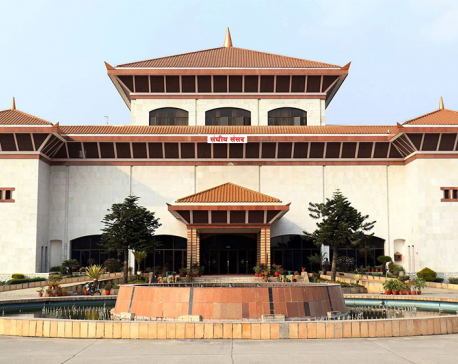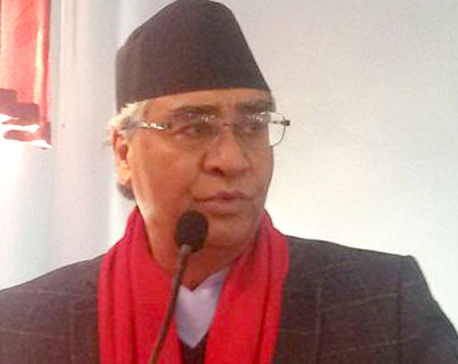
OR
Chure conservation
Main concern left out in provincial government's policy and plan
Published On: April 10, 2018 05:00 AM NPT By: Devendra Basnet

DANG, April 10: On Sunday, the provincial government of Province 5 unveiled its plans and policies in which it focused mostly on the development agricultural and industrial sector as the basis economic development. Though the government has set out agricultural development as its major agenda, which it claims to achieve in part by utilizing water in rivulets for irrigation, it has not set out plans for conserving the Chure region that is essential for preserving water sources in the region, among others.
Locals claim that mafias continue to exploit jungles and other resources in the Chure region unabatedly. Felling of trees, as well as extraction of sand and stones from the rivers, continues unrestricted. Experts have repeatedly warned that the rampant and unrestricted exploitation of natural resources in the Chure region has been severely affecting environmental conditions in the region and that such environmental degradation might invite severe natural disasters in the region.
Every year, rivers are disappearing and with them the area of barren land is also increasing. - Dr Shiva Kumar Subedi
“As long as Chure remains neglected, this region cannot develop. It must not be neglected at any cost,” notes Dr Shiva Kumar Subedi, an expert on Chure. “Until and unless we revive the natural order in Chure region and bring it back to life, water sources in the region will soon dry. Many water sources in the region have already dried,” he said.
He warns that if exploitation of natural resources continues at the present rate, it will trigger natural disasters of huge scale and that such disasters will be not limited to the Tarai region.
Subedi stated that the policy makers have still not realized the importance of preserving the Chure region to ensure sustainable economic development across the country. Citing its importance in the overall national development, he stressed that the federal as well as the provincial governments should prioritize its conservation at the policy level.
Citing common understanding among farmers in the Tarai region, he claimed the farmers are aware that their fertile lands are gradually drying up and that despite using better fertilizers productivity has been declining over the past few decades. They attribute decline in productivity, he claims, to the destruction of Chure region. “In the past, most of these farmers were able to irrigate their farms from nearby rivers and rivulets. Now most of these water sources have dried up or have very less water. This has severely affected their farms productivity. So the magnitude of the problem is already high,” he said warning that in the long-term the impact of environmental degradation in Chure region could be even dangerous.
According to Subedi, when sand and stones are extracted in excess from rivers, it is natural for them to dry up. Despite this fact, such resources are collected haphazardly from small and big rivers in the region in lack of monitoring by authorities concerned. Locals claim that trucks and tractors continue to extract stone and sands from the rivers day and night.
Requesting anonymity, a local of Ghorahi stated that the power of stone and sand mafias is so high that no one dares to speak against them. “Though among ourselves we share concerns about the rampant mining of sand and stones from the rivers, nobody dares to question the practice. If you roam around the rivers and observer their activities, you are a threat for them and possibly your life is under threat,” he narrated.
The uncontrolled mining of sand and stones in rivers have threatened the rivers, notes Subedi. He claims that level of the river base has shrunk very much in the recent years. And because of this, huge swaths of arable land have turned barren. “Every year, rivers are disappearing and with them the area of barren land is also increasing.”
Flooding is another direct derivative of Chure environmental degradation. Unlike in the past, flooding has become very much unpredictable in the region. “When you interfere with nature, it responds in every dangerous ways. This is evident in the ever increasing numbers of floods and their intensity in the region,” he stated.
Stating that dozens of villages in the region are already under huge risk of flooding he stressed on the need to tighten restrictions on the extraction of sand and stones from the rivers and mountains of the Chure region.
Umaram Nepali is a resident of Haripauri, a village near Tulasipur. He is always in fear of floods from the nearby Gwar River. “I constantly fear that someday floods from the Gwar River will sweep away our settlement. I have contemplated migrating from here to safer place, but it's not easy either,” he lamented. As a measure to safeguard the settlement, Nepali and other residents in area have approached relevant authorities for building dams along the river to control its flow.
Gwar River has its fair share of mining mafias that continue to extract sand and stones from it. Due to excess extraction of the sand and stone, the river has changed its course over the years and now poses threats to settlements in its vicinity.
People were expecting that the provincial government would address their concerns by focusing on efforts to conserve the Chure region. However, its plans and policies unveiled on Sunday were a total dejection in that regard. “Chure is getting fragile with every passing day. Something serious must be done immediately to address this. The provincial government must assume greater role in the conservation of the Chure region,” he stated.
You May Like This

'Govt's policy and programs lack concrete plan'
KATHMANDU, May 24: Naya Shakti Nepal Coordinator and lawmaker Dr Baburam Bhattarai has said that the government's policies and programs... Read More...

Govt plans to leave fixing provincial capitals for provincial assemblies
KATHMANDU, Jan 6: In a bid to avoid potential tension and protests over provincial capitals, the government has planned not to... Read More...

PM gets left alliance nod on provincial capitals, governors
KATHMANDU, Jan 5: Leaders of the left alliance have given their green signal to Prime Minister Sher Bahadur Deuba to fix... Read More...




Just In
- MoHP cautions docs working in govt hospitals not to work in private ones
- Over 400,000 tourists visited Mustang by road last year
- 19 hydropower projects to be showcased at investment summit
- Global oil and gold prices surge as Israel retaliates against Iran
- Sajha Yatayat cancels CEO appointment process for lack of candidates
- Govt padlocks Nepal Scouts’ property illegally occupied by NC lawmaker Deepak Khadka
- FWEAN meets with President Paudel to solicit support for women entrepreneurship
- Koshi provincial assembly passes resolution motion calling for special session by majority votes







_20220508065243.jpg)






Leave A Comment